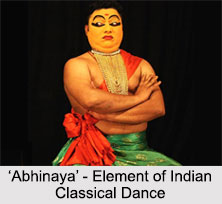 Elements of Indian classical dance as per "Abhinaya Darpana Prakasha" are divided into three distinct categories, namely, "Natya", "Nritya" and "Nritta". "Natya" is related to drama and "Nritya" to the gesture accompanied by a musical composition. "Nritta" refers to pure dancing where the body movements do not express any meaning. All these aspects use movements of the limbs and poses of the human body as their medium.
Elements of Indian classical dance as per "Abhinaya Darpana Prakasha" are divided into three distinct categories, namely, "Natya", "Nritya" and "Nritta". "Natya" is related to drama and "Nritya" to the gesture accompanied by a musical composition. "Nritta" refers to pure dancing where the body movements do not express any meaning. All these aspects use movements of the limbs and poses of the human body as their medium.
Different Elements of Indian Classical Dance
The universal root of all Indian classical dance forms can be related to "Bharata"s Natyashastra". According to the "Natyashastra", Lord Brahma is the originator of the Universe and he has created the drama. The Indian classical dance forms are directed by the essential elements of an act with "abhinaya" and "rasa". Following are the different elements of Indian Classical Dance:
Abhinaya: The "Abhinaya" is general to all the classical Indian dance forms. Throughout the "abhinaya", viewers experience the particular emotions of the character or the situations that are represented by the performers. "Abhinaya" is the expressional characteristic of dance or `nritya`. There are four types of "Abhinaya" and these are - "Angika", "Vachikabhinaya", "Aharyabhinaya" and "Satvikabhinaya".
Tandava and Lasya: "Tandava" and "Lasya" are the two other major elements. "Tandava" is a dance which is performed for the adoration of the gods and its gentler aspect termed as "sukumara-prayoga". "Lasya" is used as a synonym of "Tandava" occasionally. "Lasya" is one of the forms mentioned in the description of ten types of Drama. "Abhinaya Darpana" and "Sangitaratnakara" describe "Tandava" as the derived from of "Tandu" and "Lasya".
Navarasas: "Navarasas" or the nine emotions of dance complete all the performances. "Navarasas" is very significant in a dance act, since it permits the dancer and the "rasikas" or the audiences to experience the full splendour and meaning of the lyrics. The "Navarasas" are given below:
•Hasya
•Sringara
•Karuna
•Bhayanaka
•Raudra
•Veera
•Bibhatsa
•Adbhuta
•Shanta
Nritta and Nritya: "Nritta" and "Nritya" are the two categorizations of the techniques of dancing. "Nritta" is the law and methodology of human movement. "Nritta" encompasses the technique of rendering the rhythm through the movements which have certain meanings and projecting specific poses within a given rhythmic cycles. Indian classical dance is least concerned about the break and time as the dancer is constantly trying to achieve the perfect pose. The human form here achieves geometrical shapes in time rather than in space as the difficulty of "Nritta" depends on the very fine and deliberate manipulation of rhythm to achieve a series of poses. An Indian classical dancer believes the united and basic anatomical bone structure of the human appearance as the foundation. From this the dancer strives to achieve the absolute form.
Pindibandha: The most important term in the field of dance composition found in "Natyashastra" is the "pindibandha". The "pindis" are believed to have four varieties namely "Gulma", "Srinkhaia", "Latabandha" and "Bhedyaka". "Gulma" stands for a group dance. "Srinkhaia" stands for a chain formation with the partners holding their hands. "Latabandha" suggests a dance masterpiece where the dancers put their arms around each other. The "Bhedyaka" is a solo dance. All these are employed in the beginning of the play and related to "Asaritas" of various kinds. This covers all points of articulation of a human body.
Karana: "Karana" is the fundamental unit of dancing and "Natyashastra" has approved 108 "Karanas".
Recakas: "Recakas" are described as the central movements of the feet, hips, hands and neck which Bharat Muni explained in chapter four of "Natyashastra" .



















